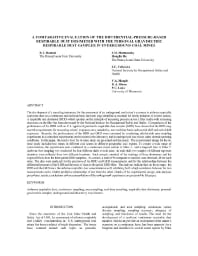Mining Publication: A Comparative Evaluation of the Differential-Pressure-Based Respirable Dust Dosimeter with the Personal Gravimetric Respirable Dust Sampler in Underground Coal Mines
Original creation date: January 2001
Authors: RV Ramani, JM Mutmansky, JC Volkwein, VA Marple, BA Olson, PC Luna
NIOSHTIC2 Number: 20021416
Proc Seventh Intl Mine Ventilation Congress. Krakow, Poland: Research and Development Center for Electrical Engineering and Automation in Mining - EMAG, 2001 Jan; :243-251
The development of a sampling instrument for the assessment of an underground coal miner's exposure to airborne respirable coal mine dust on a continuous and real-time basis has been long identified as essential for timely initiation of control actions. A respirable dust dosimeter (RDD) which operates on the principle of increasing pressure across a filter media with increasing dust mass on the filter has been developed by the National Institute for Occupational Safety and Health. Comparisons of the performance of the RDD with an U.S. approved gravimetric respirable dust sampler (GRD) have shown that the RDD may meet the requirements for measuring miners' exposures on a cumulative, near real-time basis such as mid-shift and end of shift exposures. Recently, the performances of the RDD and GRD were compared by conducting side-by-side area sampling experiments in a controlled experimental environment in the laboratory and in underground coal mines under normal operating conditions. In this paper, the results from the in-mine study are presented and discussed. The experimental design for the in-mine study included two mines in different coal seams in different geographic coal regions. To ensure a wide range of concentrations, the experiments were conducted in a continuous miner section in Mine 1, and a longwall face in Mine 2. Airborne dust sampling was conducted for four different shifts at each mine. In each shift, two samples of different exposure durations were collected from two different locations. Each sample consisted of the readings of three dosimeters and the exposed filters from the three paired GRD samplers. As a result, a total of 96 comparative samples were obtained, 48 for each mine. The data were analyzed for the precision of the RDD and GRD measurements and for the relationships between the differential pressure of the RDD and the mass of dust on the paired GRD filter. The analyses indicate that, on the average, the RDD and the GRD track the airborne respirable dust concentrations well, exhibiting both a high correlation between the two measurements and a reliable predictive relationship of one from the other. Details of the experimental design, data analyses procedures, results, conclusions and recommendations of the underground experiments are presented in this paper.

NIOSHTIC2 Number: 20021416
Proc Seventh Intl Mine Ventilation Congress. Krakow, Poland: Research and Development Center for Electrical Engineering and Automation in Mining - EMAG, 2001 Jan; :243-251
- A Comparison of Respirable Crystalline Silica Concentration Measurements Using a Direct-on-filter Fourier Transform Infrared (FT-IR) Transmission Method vs. a Traditional Laboratory X-ray Diffraction Method
- Evaluating the Use of a Field-based Silica Monitoring Approach with Dust from Copper Mines
- Evaluation of LIDAR as a Novel Remote Dust Sensing Technology
- Laboratory Comparison of New High Flow Rate Respirable Size-Selective Sampler
- Reducing Silica and other Respirable Hazards in the Industrial Minerals and Metal/Nonmetal Mining Industries
- A Revised Conversion Factor Relating Respirable Dust Concentrations Measured by 10-mm Dorr-Oliver Nylon Cyclones Operated at 1.7 and 2.0 L Min^(-1)
- Selected Publications on EVADE Software, Helmet-CAM, Dust Exposure, and Behavioral Studies
- Technology News 463 - Machine-Mounted Continuous Respirable Dust Monitor
- Technology News 509 - A New Method to Clean Dust From Soiled Work Clothes
- Test Report on the Machine-Mounted Continuous Respirable Dust Monitor